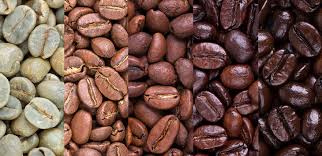Light, Medium or Dark
Date Posted:5 July 2014
you get different results from roasting coffee light, medium or dark.

What does it really mean ?
Roasting coffee goes back a couple of hundred years to the original discovery by Kaldi the goat shepherd in Yemen observing his flock becoming physically excited after eating the cherries from certain types of trees.
The cherries became seeds (beans) and the subsequent evolution in "cooking" the raw coffee from pan frying, wood or coal fuels to fire the drums/vessels and into today's advanced roasting plants with extremely precise computer controls.
It has really been in the last 30 years where evolution and improvement in coffee bean quality have been driven by the preparation of beverages - historically, the espresso machine and now more recently the portion control systems such as pods and capsules and emerging hipster-styles like siphon, cold-drip, etc.
As an industry, we are still talking about coffee beans in the wrong language and essentially stuck in a 30 year time warp when the only options for coffee offered were the old light, medium and dark roasts.
This terminology has conditioned consumers to focus their coffee bean selections on the outdated choices of seeking either strong coffee bean or something that is "not bitter".
So how does this actually translate into the modern style of coffee bean roasting where you have a broad range of Single Origin coffee beans processed using increasingly higher quality controlled environments, e.g. special patio dried coffees, honey-processed, etc. Farmers are improving their processing techniques and removing the ratio of defects from the coffee beans.
Let's start by discussing the roast depth - light, medium or dark.
The concept of roast depth is a throw back to the older styles of coffee roasting when the raw coffee bean quality was of a lower standard and coffee roasters would deal with this problem by roasting the bean a lot darker in an attempt to "burn out" the majority of defects.
What they ended up with was a homogenous coffee bean product that had the characteristics of coffee with some elements of bitterness and ashy flavours. As coffee roasting companies grew larger, they looked at ways of reducing input costs by purchasing cheaper and lower grade raw coffee beans. The objective was to send the defects up the chimney as "smoke".
Can't help it - attracted to the Dark Side?
The longer you roast coffee, the darker the end "colour" result and the lower the acid.
Acid is the most important aspect to manage when roasting coffee beans. Acid can be pleasant when it is in balance, or unpleasant when it is too high or tend towards sour when too low.
Darker roasted coffee beans do not automatically mean you end up with a stronger flavour - this is the most common misconception (or mistake) when it comes to a consumers' individual understanding of coffee flavour. Flavour is influenced more by dosage levels, perfectly matching the grind setting to the correct brew and extraction and of course the temperature and brew efficiency and effectiveness - ok, that's a mouthful, but basically when you have all this right and you nail it, then the flavour is abundant.
Dark roasted coffee beans have less fruit and original character - it is roasted out of the bean. Darker roasted coffee beans may have more caramel and chocolate notes, especially when added with milk, but this is a very delicate balance as there is an extremely fine line before it becomes ashy and/or bitter.
Some coffee bean work better with a darker roast than others. Typically, hard and dense beans from Central America and some African beans grown at high altitude such as Kenya, Ethiopia and Tanzania can handle darker roast depths. Soft beans from the likes of Brazil, Colombia, Peru and some Sumatrans or natural processed coffees do not work as well roasted darker.
Can you see the Light?
Over the last 3 - 5 years, the trend for roast depth in Australian cafes has progressively become lighter and lighter, driven mainly by Specialty Coffee cafes wanting to push the boundaries of quality and showcase the true attributes of a specific coffee bean - preserving the fruit, enhancing the character and delivering more in the cup.
Lighter roasting can also avoid some of the pitfalls of ashy/bitter taints - however, that in itself can be a function of extraction efficiency - a poor espresso shot of lightly roasted coffee beans will still taste terrible - perhaps worse than a medium or dark roasted coffee bean.
Sometimes it is a religious debate in the coffee industry - the light roast brigade (sometimes referred to as "hipsters") think anything roasted close to medium will destroy the coffee. Light roasted coffee fanatics also tend to prefer non-espresso brew methods, such as siphon, filter, cold-drip, etc. that increase the fruity aspects without the taints caused by espresso extraction.
Light roasted coffee tends to have lower levels of body - this is best described as the "mouth feel" or texture you experience. Light roasted coffee beans also have very high acid if not extracted correctly via espresso may taste sour, grassy, woody or even bitter.
At the extreme end of light roasted coffee, to prepare a traditional milk-based beverage such as a cappuccino, latte or flat white, you would not be alone in thinking the coffee was mild, light, sweet and not entirely what you were expecting.
For this reason, the light roasted coffee beans tend to end up being used for non-espresso brew methods.
Finding that sacred Middle ground
Identifying the appropriate roast depth for any particular coffee bean is challenging. You start out by understanding the bean's screen size, moisture levels and relative density but it's only when the coffee bean is inside the roasting chamber and you observe what is happening that you develop the knowledge required to handle the coffee.
Sometimes, the theory you apply when roasting a coffee bean may not translate into the best result when the coffee is tasted (or cupped) after roasting. As an example, we have 4 different Guatemala coffee beans in our roastery and I've found that they each prefer a slightly different roasting profile.
There are basically two approaches you could take when roasting coffee - is it for milk, or black ? (normally referred to as espresso, but could mean other brew types). The reason we think about this choice is because the act of adding milk to an espresso changes the acid balance of the coffee.
In Australia, around 90-93% of the espresso coffees are prepared for milk to be added. This means you need to think about having some type of "positive acid" balance for the coffee.
Most of the cafe coffees I sample in Melbourne cafes when I'm out and about from other coffee roasters do not work so well as a black espresso - ristretto, short-black or even a long-black.
Why ?
One explanation is because they have got caught up in the trends for lighter roasting and may not have adapted their raw/green bean purchasing to source cleaner and higher quality coffee beans. Their traditional approaches to "roast out" defects may not be precisely matched with the green beans.
Another reason is that coffee roasters are constantly seeking sweeter and fruitier cups whilst at the same moment they are obviously not taking the time and effort required to fully understood the acid levels in the raw coffee beans they are using.
Picking a spot in the middle is difficult. Whilst most other things in life are generally regarded as "mediocre" when referring to being in the middle, when it comes to the world of coffee bean roasting, preparing something that might appeal to a broad majority is actually very challenging.
Medium roasted coffee beans are rich, smooth, creamy and will have a "bit of everything" if they are roasted and blended correctly - little bit of fruit, chocolate, caramel, nut and sweet if you extract or brew it perfectly. 9 time out of 10 when people are describing a memorably coffee, this is what they want.
We roast a larger variety of coffee beans than almost any other coffee company in Australia. We can do 15 - 25 different coffees each night, 6 nights a week. Most other coffee roasters will run just a few blends and perhaps a couple of single origins and normally they will run just 1 or 2 types of coffees when they perform a roasting session.
Our regime is extremely tough and difficult and at times I wish it was simpler - but, it has developed and bred a high level of knowledge and experience for us in how coffees are best handled.
We also map the direct feedback from the Specialty Cafes we supply, enabling us to constantly optimize our roast profiles.
Based on all the input data, feedback and references we can analyse, we have formed quite solid ideas on how to roast our coffees in the right balance to appeal to the broader majority.
Coffee does not need to be "strong" in order to appeal. Customers need to keep in mind that strength is a function of how you grind, dose and brew or extract the coffee.
The most enjoyable moments with coffee are based around a "rich, smooth and creamy" experience.
We believe this description is where our coffees are focused with an emphasis on RICH - a long finish that is persistent well after you have finished the cup.



